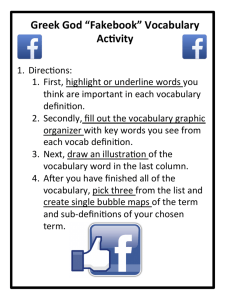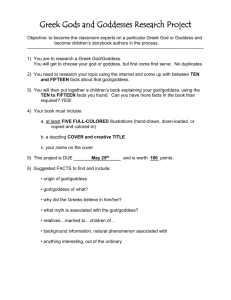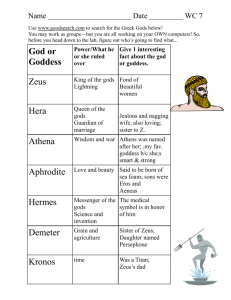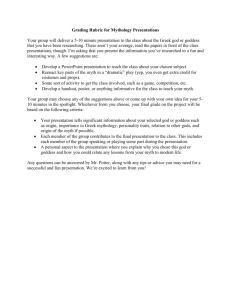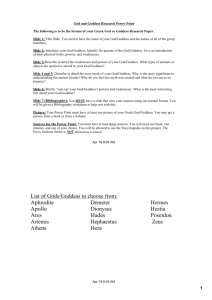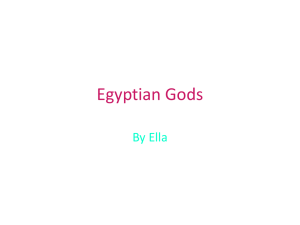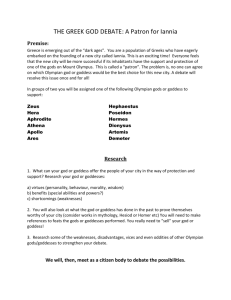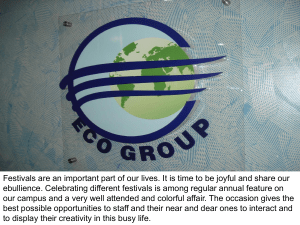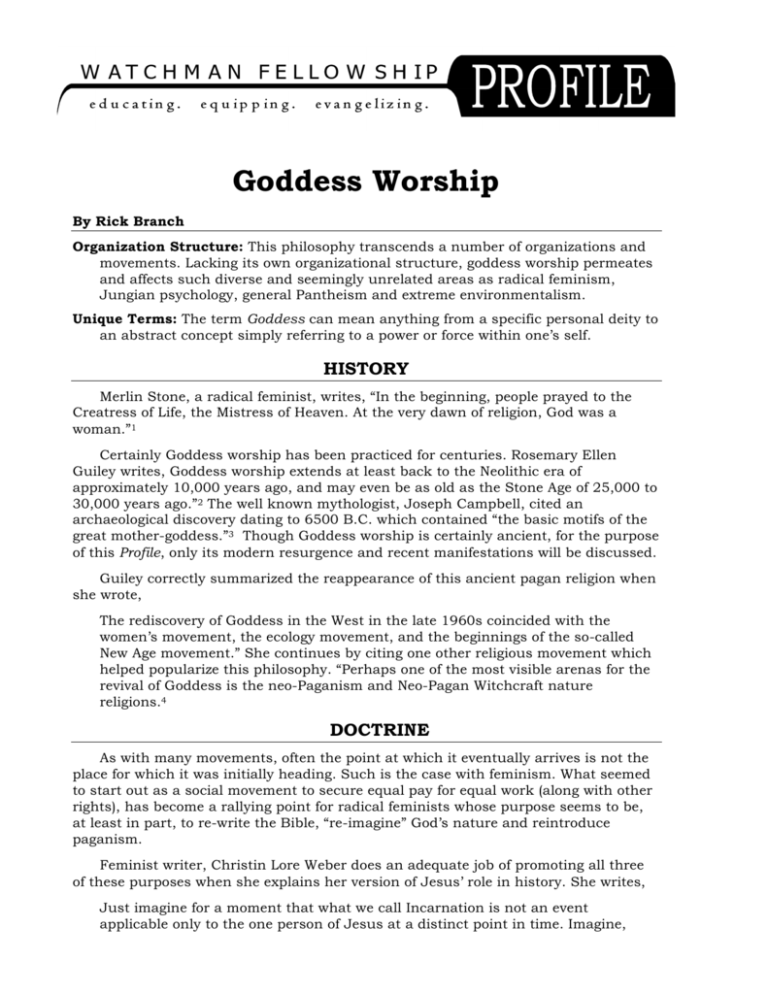
Goddess Worship
By Rick Branch
Organization Structure: This philosophy transcends a number of organizations and
movements. Lacking its own organizational structure, goddess worship permeates
and affects such diverse and seemingly unrelated areas as radical feminism,
Jungian psychology, general Pantheism and extreme environmentalism.
Unique Terms: The term Goddess can mean anything from a specific personal deity to
an abstract concept simply referring to a power or force within one’s self.
HISTORY
Merlin Stone, a radical feminist, writes, “In the beginning, people prayed to the
Creatress of Life, the Mistress of Heaven. At the very dawn of religion, God was a
woman.”1
Certainly Goddess worship has been practiced for centuries. Rosemary Ellen
Guiley writes, Goddess worship extends at least back to the Neolithic era of
approximately 10,000 years ago, and may even be as old as the Stone Age of 25,000 to
30,000 years ago.”2 The well known mythologist, Joseph Campbell, cited an
archaeological discovery dating to 6500 B.C. which contained “the basic motifs of the
great mother-goddess.”3 Though Goddess worship is certainly ancient, for the purpose
of this Profile, only its modern resurgence and recent manifestations will be discussed.
Guiley correctly summarized the reappearance of this ancient pagan religion when
she wrote,
The rediscovery of Goddess in the West in the late 1960s coincided with the
women’s movement, the ecology movement, and the beginnings of the so-called
New Age movement.” She continues by citing one other religious movement which
helped popularize this philosophy. “Perhaps one of the most visible arenas for the
revival of Goddess is the neo-Paganism and Neo-Pagan Witchcraft nature
religions.4
DOCTRINE
As with many movements, often the point at which it eventually arrives is not the
place for which it was initially heading. Such is the case with feminism. What seemed
to start out as a social movement to secure equal pay for equal work (along with other
rights), has become a rallying point for radical feminists whose purpose seems to be,
at least in part, to re-write the Bible, “re-imagine” God’s nature and reintroduce
paganism.
Feminist writer, Christin Lore Weber does an adequate job of promoting all three
of these purposes when she explains her version of Jesus’ role in history. She writes,
Just imagine for a moment that what we call Incarnation is not an event
applicable only to the one person of Jesus at a distinct point in time. Imagine,
THE BEST RESOURCE COLLECTION ON CULTS AND RELIGIONS
The Watchman Fellowship Profile
Notebook provides you with an extensive personal library of information about cults, new and alternative religions, world religions, and
religious leaders. You will have at
your fingertips over twenty years of
research to answer your questions,
strengthen your faith, and improve
your witness to others.
•
•
•
•
Over 100 Profiles
Over 400 pages of information
The history and primary teachings of
each group
A Christian response
to deepen your faith
and enhance your outreach
Click here to order your copy of the watchman fellowship profile notebook
Be sure to also order your free subscription to the Watchman Fellowship Profile. Several times
each year you will receive a new, four-page Profile that you can add to your Profile Notebook, as
well as the latest news from Watchman Fellowship. Click here to order your free subscription!
Goddess Worship, page 2
instead, that Incarnation is a non-historical quality of the creative process of
Ultimate God-Mystery that transfigures created beings, radically shifts all
consciousness in the cosmos, and results in what is earth-created matter
becoming transformed into God.
What distinguishes Jesus from the rest of us is that he knew, was conscious of,
who and what he was. He knew he was God’s Word; that is not to say the rest of
us are not. As women, we have a particular responsibility, for God incarnated in
our being may add a dimension to cosmic consciousness, as well as to the Christ,
that cannot be imagined in a creation expressed by a primarily masculine spirit.
We have a responsibility to descend into, become one with, and then unfold the
womanness of God in creation. That is how we become Christ.”5
Going the next step beyond Weber’s WomanChrist, Monica Sjoo and Barbara Mor
introduce the Goddess. “Perhaps ancient women had access to psychic and physical
powers we have forgotten. Ancient people of both sexes, living under the Stone Age
Great Mother had ‘magical’ power of telepathy, clairvoyance, precognition,
teletransportation, of fire-walking and shape-changing.”6
For many proponents, an integral part of Goddess worship is its prevalent theme
of anti-masculine, anti-male statements. In this philosophical world-view, since
Goddess worship is good, then by necessity, any use of masculine terminology in
reference to God or any prominence of men in culture or society is generally
discouraged. Sjoo and Mor explain this thought by writing,
Perhaps the greatest harm patriarchy has done to us is to stifle, coopt, and deform
our powers of imagination. Moralism, dualistic dogmas, repressive prohibitions
block our imagination. Patriarchal religions keep this fusion from happening,
imagination dies, and is replaced by mechanical-linear thought patterns, i.e.
indoctrination.7
This “blocked imagination,” they claim, leads to harmful indoctrination. This
indoctrination includes the biblical concept of God the Father and God the Son. Hence
the need to re-imagine God in a Goddess nature with feminine qualities.
Starhawk, a self-proclaimed witch, explains, “The symbolism of the Goddess has
taken on an electrifying power for modern women. It has exposed the falsehoods of
patriarchal history, and given us models for female strength and authority.”8
Elinor W. Gadon noted in her book, The Once and Future Goddess, another strain
in recent history that has brought the concept of Goddess worship to the forefront.
She writes, Psychologist “C.G. Jung discovered that the Goddess was a potent force in
the unconscious. Jung’s theory of the feminine principle as a universal archetype, a
primordial, instinctual pattern of behavior deeply imprinted on the human psyche,
brought the Goddess once more into popular imagination.”9
Not only has the Goddess been written about in New Age/Occult books, touted by
noted psychologists as being a universal part of the human psyche and heralded as a
rallying point for anti-Christian feminists, she is also being spoken of in public schools
throughout America.
Tal Brooke, a Christian author and researcher with the Spiritual Counterfeits
Project in Berkeley, California stated, “Children watch plays about Mother Earth; they
are taught that to despoil the goddess who gave them birth by polluting the
environment is more than just ecological crime, it is essentially blasphemy.”10
Goddess Worship, page 3
The Goddess Earth: The Gaia Hypothesis
How did this pagan philosophy of the Goddess gain access to the educational
system? It began with the British scientist, James Lovelock, who, while “working on
the problem of detecting extra-terrestrial life” claimed his Gaia hypothesis “began to
take shape.”11 Lovelock explains, “Gaia is Mother Earth. Gaia is immortal. She is the
eternal source of life. She is certainly the mother of us all, including Jesus.”12 His
belief, as stated in the Gaia hypothesis, is that Mother Earth is the goddess Gaia. It is
a living, breathing being. It is a ““single, self-regulating biological organism that acted
intelligently and beneficently to maintain life.”13
Joss Pearson, a devout believer in Lovelock’s Gaia hypothesis, explained, “I
realized his theory would change the whole of science, every science there is maybe
not instantly but certainly over time.”14
The Goddess in the Classroom
One way to insure that Lovelock’s theory of Mother Earth/Goddess Gaia as a
living entity and man as an ordinary organism will be accepted by future generations
is to begin by teaching it to the youth. That is precisely what is happening. In an
elementary age, Environmental Science textbook, copyright 1995, this very Gaia
theory is explained and stated as a viable probability. It declares,
The perception of Earth as a living being is a view held by people in many
cultures. However, in modern industrial society, humans are often seen as being
apart from nature. Nature is something to be controlled and consumed. Many
people view Earth as existing for human use. People are removed from the systems
that govern the rest of the biosphere. The modern industrial view does not match
the portrait of Earth. Like any other population of organisms, humans are part of
Earth’s systems. The principles that govern lynx and hare populations in the
ecosystem govern the human population as well. Scientists are now beginning to
study these connections among systems. In 1972, British scientist James Lovelock
proposed a hypothesis called the Gaia hypothesis. The Gaia hypothesis states that
Earth is a single, living organism that regulates itself to maintain life. Lovelock’s
hypothesis reflected a view of Earth that many cultures have held for thousands of
years.15
While it is certainly accurate to say that Lovelock’s view has been held by many
cultures for thousands of years, it is also worth noting that no civilized culture has
held it in recent centuries. It is a tenet of pagan religion directly related to Pantheism
and goddess worship.
Thus, ecology in the school system has joined with radical feminism under the
banner of Goddess Gaia/Mother Earth. David Pearson, a believer in the Gaia theory,
explains, “Far from being masters of nature, we as humans are an integral part of
Gaia. It’s fundamental to our new vision of the three interwoven strands of the Gaian
approach: ecology, health, and spirit.”16
Where does the Gaia Goddess theory of ecology eventually lead? As Pearson has
explained, it is essential for Mankind to learn to intertwine ecology, health and spirit.
That is why Jalaja Bonheim can write a Walking Prayer for the Earth which harmonizes
these three aspects.
She states, “The earth is not dead matter. She is alive. Now begin to speak to the
earth as you walk. You can speak out loud, or just talk to her in your mind. Send your
love into her with your exhalation. Feel your heart touching upon the heart of the
planet. Say to her whatever words come to you: Mother Earth, I love you. Mother
Goddess Worship, page 4
Earth, I bless you. May you be healed. May all your creatures be happy. Peace to you,
Mother Earth. On behalf of the human race, I ask forgiveness for having injured you.
Forgive us, Mother Earth.”17
Thus, from radical feminism and pagan witchcraft to elementary school textbooks,
Goddess worship, in its many manifestations, is ever creeping into modern society.
BIBLICAL RESPONSE
1) The earth is created by God (not a goddess) and the earth is not the creator
(Gen. 1-2; John 1:2-3; Col. 1:16).
2) All (male and female) are equal in God’s sight (Gal. 3:28).
3) God universally chose to use masculine pronouns in reference to Himself
(Genesis to Revelation).
4) God chose to reveal Himself uniquely in the person of the man Christ Jesus
(John 1:1-14; 1 Timothy 2:5).
5) God condemns the worship of other gods and goddesses (Exodus 20:3; Deut.
12:1-32; 1 Kings 11:1-40; Psalms 94:4-5; Jeremiah 7:18, 44:1-30; Acts 19:24-41).
6) God gave humanity dominion over the earth, not to be subject to the earth or to
worship it (Gen. 1:26-28).
RECOMMENDED READING
Under the Spell of Mother Earth, Berit Kjos. This book covers all the bases. It
discusses Mother Earth, Goddess, Gaia, Witchcraft, New Age Ecology and Globalism.
204 pages, Index.
The Earth is the Lord’s: Christians and the Environment, Richard Land and Louis
Moore, editors. Biblical perspective on the Christian’s place in the ecological
movement. Includes information on New Age and Humanistic approaches. 207 pages.
Notes
Meril Stone, When God Was A Woman, (New York: Dorset Press, 1976) 1.
2 Rosemary Ellen Guiley, Encyclopedia of Mystical and Paranormal Experiences, (New York: HarperSanFrancisco, 1991), 239.
3 The Masks of God, vii.
4 Guiley, 240-241.
5 Christin Lore Weber, WomanChrist: A New Vision of Feminist Spirituality, (San Francisco: Harper & Row, 1987) 43-44.
6 Monica Sjoo & Barbara Mor, The Great Cosmic Mother: Rediscovering the Religion of the Earth, (New York: HarperSanFrancisco, 1991)
425.
7 Ibid, 427.
8 The Spiral Dance: A Rebirth of the Ancient Religion of the Great Goddess, 91.
9 Elinor W. Gadon, The Once and Future Goddess, (New York: HarperSanFrancisco, 1989) 228.
10 Tal Brooke, “Gaia-A Religion of the Earth,” SCP Journal Vol. 16 No. 1 1991, 4.
11 James Lovelock, Science and Christian Belief, Vol. 4, No. 1, 29
12 Ibid, 6.
13 Richard Leviton, “Thinking like a planet,” Yoga Journal, March/April, 1992, 26.
14 Ibid.
15 Ecology and Human Impact, 188-189.
16 Leviton, 31.
17 New Age Source Book 1994, 45.
1
Profile is a regular publication of Watchman Fellowship, Inc. Readers are encouraged to begin their own
religious research notebooks using these articles. Profiles are published by Watchman Fellowship
approximately 6 times per year, covering subjects such as new religious movements, counterfeit
Christianity, the occult, New Age Spirituality, and related doctrines and practices. Complete Profile
Notebooks containing all Profiles published to date are available. Please contact Watchman Fellowship
for current pricing and availability. All rights reserved © 1994.

